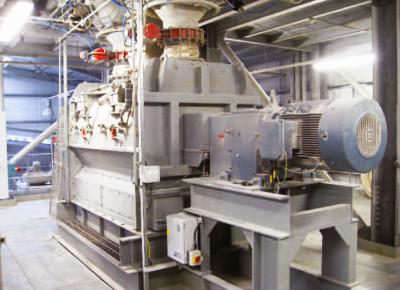Energy saving mixing in a green factory.
A J R Boone Delta Blade Mixer has found favour at F Ball, a leading manufacturer of cementitious flooring. The mixer is an integral part of a new factory development that combines high efficiency with extremely low energy usage.
Thorough mixing with a minimal mix cycle is key in a factory where six batches may be in process at any one time.
John R Boone have supplied an energy efficient Horizontal Delta Blade mixer to cementitious product manufacturer F Ball Ltd for high speed mixing with low power consumption, achieving a high throughput with a very short mixing cycle. The highly efficient process comprises weigh hoppers that feed the JR Boone mixer, discharging via a ‘bomb’ door to an under hopper that feeds a packaging and palletisation line beneath; a process that requires good control and a short mixing cycle to achieve the total batch time of under two minutes for a 2 tonne mix.
The history of F Ball, the UK’s leading producer of flooring adhesives, leveling products and grouts, goes back 125 years, originating as an ink manufacturer, moving from London to Staffordshire during the second world war and into a purpose built factory on an eight acre site in 1989. It was in the early 1990’s that they installed their first mixer from John R Boone Limited and so began a relationship that has continued and developed, leading to their latest purchase of a Boone Horizontal Delta Blade Mixer for high speed production in their new powder mixing plant.
The new plant is designed to produce up to 30 tonnes of blended material per hour. At any time there may be as many as six batches within the process: one in each of the two weigh hoppers containing the bulk materials (sand, cement) together with additives such as flow promoters and set retarders; a further batch in the mixer, mixed material in the underhopper and two further batches within the packing and palletisation line. With that amount of work in process, mixing speed and efficiency is paramount, thoroughly blending the additives throughout the bulk materials before the bomb door opens and the mixed material is deposited into the underhopper.
A key objective for the plant was that it would have as small an environmental impact as possible, and a vital part of that objective was to minimise the energy used, for example by the use of gravity fed rather than mechanically conveyed processes and making every element of the process as energy efficient as it could be, including the mixer itself. F Ball approached JR Boone for a solution, JR Boone proposing their Delta Blade technology. The Delta Blade is a plough type mixer, with a precisely engineered blade shape that uses the principles of high agitator speeds to radially and axially accelerate the product formulation in a short criss-cross pattern within the mixer shell. Higher levels of shear are produced with lower power consumption than more conventional mixers, meaning that batches are mixed quickly, thoroughly and homogenously using minimum energy, reducing the carbon footprint of the new installation.
F Ball naturally wanted to confirm all this, so John R Boone provided a test mixer on site so that the efficiency of the Delta Blade mixer could be thoroughly tested with F Ball’s materials, checking that they could achieve the batch times that they needed. Since entering service a further benefit of the Delta Blade system has been noted due to its highly efficient mixing action and despite the abrasive nature of the materials in use, no wear parts have been replaced in over two year’s operation.
As Steve Tubby, F Ball’s Operations Director, put it: ‘Our experience of Boone’s since we installed the Rotary Drum Mixers back in 1991 has always been very positive, we have been able to rely on their support whenever we have needed it. The Delta Blade mixer was exactly what we were looking for, a fast, energy-efficient solution that gave a consistently high quality mix in the shortest time possible. Boone’s engineers were extremely responsive throughout the project and clearly understood what we were trying to achieve.’

